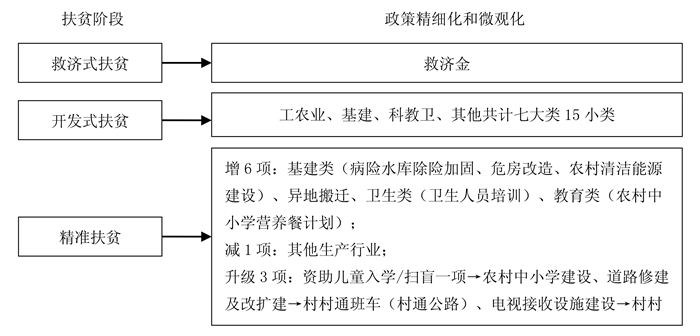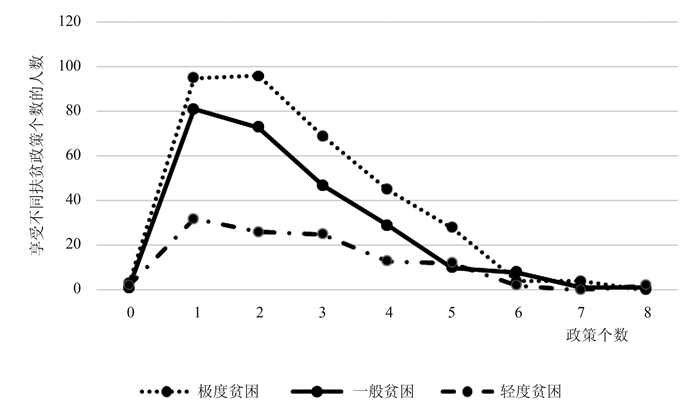全文HTML
-
绩效的概念,最早出现于泰勒的企业管理中,用于企业员工的差异化薪酬激励[1]。将绩效评估与绩效管理运用到政府的公共管理中来,则始于美国在20世纪50年代实行的绩效预算制度,主要解决政府部门优化、减少部门之间内耗和实现政府内部各部分之间基于目标的动态的一致性问题[2]。20世纪70年代末的“新公共管理运动”以所谓的“3E”为目标(Economy、Efficiency、Effectiveness),强调以服务型政府取代管制型政府的同时,绩效问题的焦点亦由组织、结构与过程管理转移到公共项目及其所产生的结果管理上,对结果负责而非以投入为标准来拨款,政府扮演了“企业家政府”的角色,变得更有效率和更富于企业家精神[3]。其后,绩效问题作为公共部门中的焦点问题,世界各国以政府为中心的公共部门开始逐步将绩效当作提高政府工作效率和公共服务质量的重要手段。20世纪90年代后期以来的新绩效思想认为,公共部门在追求“企业家政府”的政府再造过程中过分追求效率至上将逐步失去公共性这一基本特性,而失去了公共性的公共部门就等同于私人部门了,政府绩效评价若是只强调工具理性而不考虑价值理性的话,那么它也就失去了存在的价值仅和一般工具绩效评估无二,进而出现从经济绩效到公共价值的回归[4],与政府绩效相关的绩效的目标是社会目标与结果,而非直接的经济产出或活动。当前,美国、英国等发达国家绩效评价的侧重点稍有不同,但基于效率、秩序、社会公平和民主的多维度绩效评价的基本价值取向却是趋同的。这些价值取向在绩效评估过程中,具体通过管理效率与能力、公共责任、公众满意程度等价值判断体现在对困难群体的社会保障制度上[5]。延伸到发展中国家,发达国家以世界银行、国际货币基金组织等为平台对发展中国家实施的扶贫项目多以“参与式扶贫项目”形式,认为扶贫不仅是帮助贫困主体收入增长,还要赋予贫困主体更多的权利(包括参与权、决策权、发言权、监督权等等)。
不同于发达国家,发展中国家和地区财政扶贫政策考核绩效差异较大。非洲可以说是西方参与式扶贫理念的试验场。其一,自身发展能力弱,扶贫资金主要来源于援助资金。其二,殖民文化的影响较深。一些会英语、法语的精英在法国浪漫主义平等至上和英国费边主义均贫富乌托邦思想的影响下,使用扶贫资金时重人权轻发展。比较有代表性的人物Veronica M. O.在对肯尼亚社区组织扶贫绩效影响因素进行研究时,考虑了社区组织的融资水平、技术变革程度、社区支持力度、透明度及责任感4个方面共计21个因素[6]。里面包含了大量的权利指标,最终导致扶贫项目的生产产出水平、收入和利润以及解决项目成员需求的能力效果不佳(即无法实现造血功能)。诸多学者都得出同样的结论,甚至认为“援助是政治、经济和人道主义的灾难”[7]。印度和巴基斯坦政策侧重促进农业发展和就业来缓解贫困,财政扶贫资金主要用于各种基础设施投资(包括实体基础设施、社会基础设施以及农田灌溉设施)和对农业生产信贷的支持,用减贫率、农民收入、粮食产量等产出指标考核绩效。Sanjeet针对印度最大的社会福利计划(MGNREGA)考核绩效所设定的指标明确指向通过增加农村就业来减轻贫困,该指标体系包括3个投入指标——工资、材料及行政支出,5个产出指标——未获得就业支持的家庭户数、所有人的工作天数、SC&ST人员的工作天数、妇女的工作天数、工作少于100天的户数[8]。巴西2003年以来展开大规模反贫困行动,先后推出“零饥饿”计划和“无贫困计划”。前者主要解决成千上万巴西人的食物和营养安全问题,其中独创的“家庭补助金”政策主要为政府对贫困家庭妇女少量的现金帮扶,稳定的货币收入不仅有助于消除贫困,对个人的自主性和政治参与度均有积极影响[9]。后者将改善国民的生活水平为目标,在消除绝对贫困同时,将提供公共设施、技能培训、促进教育、卫生和就业等纳入财政扶贫和绩效考核范畴。总的来说,巴西更偏向于保障绩效和能力绩效。发源于孟加拉的GB扶贫模式(即Grameen Bank)主要向贫困人口提供小额信贷支持服务,同时开发贫困人口能力。强调市场化运作扶贫资金,将农民的还款能力作为绩效考核的着力点。
中国政府鉴于财政扶贫资金投入有限,以发展带动脱贫的政策取向比较明确,企业型政府视角追求政策的经济效率(投入-产出效率)最大化,一直是我国绩效考核的重要构成部分。中国对财政扶贫资金大规模投入和政策绩效的研究始于1986年国务院扶贫开发领导小组成立之后。有限投入下,财政资源的使用必须贯彻勤俭办事的方针,主要强调厉行节约,反对浪费。但没有建立正式的绩效考评制度,政府既无法对扶贫项目实施必要管理,也无法对扶贫部门的工作绩效进行有效核查[10]。但有学者提出无偿的扶贫救济方式会导致财政扶贫政策效益低下,因为无偿救济易滋生贫困人口的依赖心理进而成为贫困地区扶贫开发的惰性力量[11]。以“八七”扶贫攻坚计划为标志,我国进入开发式扶贫阶段。逐步出现绩效的量化研究,最初主要用经典的贫困线测度法来识别贫困,并用减贫率指标来评估财政资金政策绩效。后来的演变表现出3大特点:一是指标越来越丰富,指标维度逐步从综合绩效、部门绩效[12]转向行政绩效、经济绩效和社会经济的全覆盖[13],具体指标从个位数指标逐步转向多达52个三级指标的设计[14];二是新方法不断引入并在精准扶贫阶段得到进一步运用,这一阶段开始采用回归分析[15]、模糊综合评判、主成分分析、层次分析法、DEA方法[16]、灰色关联分析、熵权-TOPSIS方法和反事实分析法[17]等;三是政府的绩效考核文件出台。2005年财政部和国务院扶贫办出台了首版《财政扶贫资金绩效考评试行办法》,并于2008年及2017年进行了更新。现阶段学者根据新时期的要求对财政扶贫绩效的考核的新内容:(1)在指标体系上加入生态改善指标和基于贫困社区发展的权利指标[18],部分学者开始探寻指标体系的差异性设计,分别从项目过程视角、特殊地区(民族地区、西部地区)视角分别构建了反映我国精准扶贫效果的评价指标体系;(2)注重精准性的体现,包括识别精准、项目精准、产业精准,扶贫资金的到户率与利用率等指标[19];(3)这一阶段基层扶贫干部和贫困户的主观感受和评价得到重视,通过问卷调查、访谈等方法,基于微观个体的视角分析绩效的文章逐渐增多[20]。
总的来说,在扶贫政策绩效的研究方面,国内比国外要晚一些,但国内外成果均较多。随着时间的推移,研究从管理绩效、经济绩效、社会绩效到服务绩效,国内外指标体系的设计都倾向于精细化和高维化,力图通过多层级指标设计完善绩效分析。在测度方法的选取方面,国内外较为一致,趋向于将不同的测度方法结合使用。但国内外对绩效的分析也表现出明显的差异。国外主要围绕项目展开,资金跟着项目走,绩效分析根据项目目标的实现程度来判断。而不同发展水平的国家扶贫政策差异很大,对发展中国家而言,由于贫困人口主要分布在农村,财政扶贫政策指向性明确为农村贫困地区,一般为对特定的专项扶贫项目进行具体的绩效分析,根据发展项目、保障项目、社区项目、市场化扶贫项目等建立不同考核方式。发达国家贫困人口的地域特征不明显,更多表现为种族贫困差异、阶层固化等,因此更多考虑保障、权利平等和个体的满意服务。国内反贫困政策亦主要投向农村贫困地区,借鉴国外发展中国家的研究成果较多,并注重发挥政府的制度优势,强调政策的整体使用效果,因此目前主要围绕综合绩效和部门绩效展开。
现有研究存在两大不足:第一,过于强调财政扶贫政策整体绩效,对基于农户的微观绩效研究缺失,导致政策在具体执行过程中的定位模糊而不能有效落实到贫困户。第二,对贫困户之间差异性认识不足,政策广度有余而精度不足,政策设计没有因人施策,供需不匹配问题突出。亟待从贫困户个体视角补足研究短板,提升财政扶贫政策效率。
-
我国的扶贫政策主要通过财政扶贫资金使用和投向加以体现,从其资金使用特点上探寻政策设计和实施效果,无疑具有典型代表性。新中国成立以来,政策演变大概经历三个阶段:救济式扶贫政策阶段、开发式扶贫政策阶段、精准扶贫政策阶段。由救济式扶贫到开发式扶贫,再到精准扶贫阶段,扶贫维度经历了由“单一的收入指标→兼顾经济建设与社会发展→经济与社会发展并重并强调以人为本”的转变。具体见表 1:
-
图 1从财政资金的投向上显示不同阶段财政扶贫资金政策着力点的变化:扶贫投向在分类上呈现精细化的特点。投向类别从15类扩展到19类,而且与时俱进,对部分资金的投向做了升级改进以更符合精准扶贫时期的贫困情况。同时,在基础设施建设和教育卫生配套等方面的进一步要求也体现了新时期精准扶贫工作的更高要求。与此同时,政策对象趋向微观化:在开发式扶贫阶段财政扶贫资金的规划单元为贫困县,现如今精准扶贫阶段的规划单元已经微观化到贫困村。在2005年之前,贫困人口集中的中西部特困地区、边疆地区、革命老区、民族地区一直是扶贫开发的重点,而在精准扶贫阶段,在因地施策、因人施策的指导要求下,财政扶贫资金投向要求要做到下放到村、到户、到人,让贫困个体与贫困地区均得到发展,强调财政扶贫资金要以“地”、以“人”作为资金投向的划分依据。根据《“十三五”脱贫攻坚规划》(2016),对贫困人口的帮扶从8个方面实化细化了相关路径和措施(即产业发展帮扶、转移就业脱贫、易地搬迁脱贫、教育扶贫、健康扶贫、生态保护扶贫、兜底保障和社会扶贫)。纳入生态保护扶贫的同时,充分体现了因人施策、“以人为本”的帮扶措施。这一阶段财政扶贫资金的帮扶对象实现了从区域贫困到县级、村级再到户级“贫困人口”的转变,帮扶对象将“人”作为基本单元,体现了政策对象微观化的特点。
-
(1) 政策运用的合理性:合理性的微观视角考量,最终要体现在贫困户个体的受益上,是否贫困程度与政策力度正向反馈?即贫困程度越深,政策作用力度越大。其难度在于,当财政扶贫政策的帮扶对象逐渐从区域贫困到县级、村级再到户级“贫困人口”转变的时候,参与资源分配的基层干部与贫困个体面对面时,扶贫对象对扶贫政策精准提出了更高的要求。如果微观层面不能体现绩效精准,往往引发较多的问题和矛盾。对贫困地区调研过程中发现:有的地方存在“懒汉俘获”(即愈懒愈穷,愈穷愈得到更多扶贫资源)、有的地方基层扶贫干部与村民因分配问题矛盾激化、有的地方干部为让村民打勾而贴粮、贴钱,甚至有村民要求自己选帮扶干部,认为自己得到多少帮扶取决于帮扶干部的官职大小。因此,贫困个体受益的精准性越来越成为政策绩效分析的重要构成部分。从效率的角度看,有效地分配政策,实现帕累托福利改进,是政策绩效的基本要求。
(2) 政策运用的精准性:精准性的微观视角考量,最终要体现在政策的供求匹配上,即贫困户个体得到的政策是否是他所需要的政策。依据不同的个体,采用不同的政策,形成政策的增长效应和政策的分配效应协同共振,实现社会公平和经济效率的平衡,似乎是一个难度更高的绩效要求。当下贫困地区盛行的撒胡椒面式兜底帮扶政策,无助于贫困地区经济的良性循环和自我发展。
一. 扶贫政策阶段性特征分析
二. 精准扶贫背景下实策手段精细化、实策对象微观化趋势日益突出
三. 精准扶贫对财政扶贫政策绩效分析的要求
-
精准扶贫背景下,强调扶贫资金到村、到户,以贫困户为考察对象考察财政扶贫政策绩效显得越来越重要。是否贫困程度越深代表得到的政策越多?不同政策对不同贫困程度家庭是否存在差异性?这些问题都反映了财政扶贫的微观主体绩效是否精准。本部分问卷调查的指标设计以国务院《“十三五”脱贫攻坚规划》为基础,以精准扶贫政策的惠及度为核心目标,以科学性、有效性和全面性为基本原则,分析不同收入层级的贫困户对各类财政帮扶政策的获取情况,从微观角度出发分析财政扶贫资金在精准扶贫阶段的帮扶绩效及绩效提升方向。
-
(1) 基本问题。设置了有关贫困户人均收入的三个基本问题,以期得到不同帮扶政策对不同收入层级贫困户的普惠程度:是否为建档立卡的贫困户?家庭人口总数(人)?家庭年总收入(元)?本文的研究只针对贫困户,由第一个问题可以识别出农户类型,通过后两个问题可以摸清农户收入基本情况并为随后进一步的分层化处理提供参照数据。
(2) 精准化财政扶贫政策相关问题。这部分的问题设置力图反映贫困户是否享受到相关政策,若享受到相关政策选择是(记为1),反之则选择否(记为0)。政策的选择根据国务院2016年《规划》的精神,以《中国农村扶贫开发纲要(2011-2020年)》和《中国农村贫困监测报告》(2015-2017)为参照,最终选择了8项精准化的财政扶贫政策进行问题设计:a.兜底帮扶;b.基础设施建设;c.产业发展帮扶;d.教育脱贫;e.金融扶贫;f.剩余劳动力转移;g.异地搬迁;h.生态补偿。
-
本文于2017年7-9月在连片特困地区选取了8个省下属的15个地级市(区)共计79个自然村发放调查问卷。问卷发放的对象为建档立卡的贫困农户,具体的问卷发放地点及相关数目见表 2:
回收748份问卷,主要针对是否为贫困户对问卷进行筛选,剔除无效问卷39份,得到有效问卷709份,问卷有效率达到94.79%。
对上述的709份有效问卷,按照前文说的三个收入层次进行划分,依次为:极度贫困(户人均收入3 812元以下);一般贫困(户人均收入3 812~10 000元);轻度贫困(户人均收入10 000元以上)。其中,3 812元的极度贫困线是根据2010年的2 300元的贫困线通过剔除价格指数确定的,户均收入通过家庭总收入除总人口数计算得出。
-
(1) 政策获取差异性效果分析。不同收入层次的贫困人口获取每项政策的比重也是不同的,其中,政策比重=获取某项政策人数/该收入群体总人数,比如:一般贫困人口中有25人享受到异地搬迁政策,则是25/251=9.96%。结果见表 3。
表中反映出:第一,兜底帮扶和基础设施建设扶贫在所有政策指标中占比最高,表明这两项政策惠及到绝大多数贫困人口,尤其是极度贫困者受益最多。第二,教育脱贫、剩余劳动力转移和生态补偿这三项政策与贫困程度之间负相关,即贫困程度越轻,得到这三项政策的比重越大。表明不同贫困群体对不同政策的需求差异。极度贫困者更加需要生活保障,而贫困程度较轻者则更注重发展需求,重视子女教育,同时,他们也更开放和更具有竞争意识,愿意到外地谋取更高的收入。与之相关,剩余劳动力转移之后,生态补偿政策也更容易实施。第三,产业发展、金融扶贫和异地搬迁这三项政策比例呈U字型,即极度贫困者和轻度贫困者得到的政策较多,一般贫困者得到的较少。产业发展和金融扶贫可以归为发展政策,极度贫困者和轻度贫困者尽管都享有较多这类政策,但调查过程中发现二者存在很大的差异。极度贫困者得到这些政策来自于政府和社会各界的高度重视,为助其脱贫,各类帮扶主体各种政策送上门来,以此推动2020年的脱贫目标的实现,属于“政策上门型”。轻度贫困者内生发展动能和自身发展能力均较强,为实现自我发展他们努力寻求各种政策扶持,因此得到的政策也较多,属于“政策寻求型”。而一般贫困者在各界重视程度不足和自我发展能力不强的情况下,有限的扶贫资源投入下得到发展政策自然较少。异地搬迁政策对贫困人口的帮扶呈现出这种状态与上述发展政策一脉相承,轻度贫困人口具备一定的自我发展能力,其搬迁并不需要政府的完全帮扶。极度贫困人口多居住在生态条件和生存环境最为恶劣的地区,必须对其优先实行异地扶贫搬迁政策,与此同时,一般贫困人口则不是政府优先考虑对象。
(2) 政策投入力度的效果分析。将上述的轻度贫困、一般贫困、极度贫困三类收入层次的贫困人口所享受的扶贫政策的个数进行统计,结果如下:
由图 2可以看出,不同收入层次的贫困人口所得到的帮扶政策的个数多集中在1~2个。
在每一个收入层次内部,按获取政策个数的差异进行划分,并按此划分标准对贫困人口的收入进行均值化处理。如在极度贫困人口内部,享受到1个帮扶政策的人数为N,且这N个人中第i个人的收入为yi(i=1,2,…,n),那么享受到1个帮扶政策的极度贫困人口的平均收入可记为
$ {{Y}_{1}}=\frac{1}{n}\sum\nolimits_{i}^{n}{{{=}_{1}}{{y}_{i}}}$ ,以此类推。以Yj(j=1,2,3)对应的值为因变量,享受到的政策个数为自变量,得收入层次与所享受政策个数的关系如图 3:由图 3可以看出:第一,获取政策数达到4~5个时对收入增长的影响最为明显。同一收入层次内部的贫困人口,获取的政策数少于4个时扶贫效果并不显著,多余5个时扶贫效果出现明显的边际递减。一方面说明对贫困人口的政策不能太少,施以4~5个精准化财政扶贫政策将有助于得到相对最优的政策组合。另一方面也说明政策投入并不是越多越好,过多的政策反而不利于资源的有效利用。第二,对比图 2和图 3发现,当前大部分贫困人口实际上仅享受到1~2个扶贫政策,远没有达到效果释放的4~5个政策范畴。
一. 问卷设计
二. 问卷发放、回收与初步处理
三. 问卷结果分析
-
本文在问卷调查基础上,采用统计描述性分析方法,从微观的贫困农户视角,对财政扶贫政策的精准绩效进行了深入的研究。得出结论如下:
(1) 政策短期配置绩效较为合理。一方面贫困程度越深得到的政策帮扶越多,贫困程度与政策力度呈现正向耦合;另一方面,极度贫困者得到更多的保障政策(如兜底帮扶),轻度贫困者则得到更多的发展政策(如教育脱贫、剩余劳动力转移、产业发展、金融扶贫等),政策的配置差异性较为合理。
(2) 短期目标与长期目标冲突,政策的长期绩效存在耗损。一方面政策广覆盖,大多数人得到1~2个政策,其中绝大多数贫困人口都得到兜底帮扶这个政策。是否有劳动能力,本应该作为兜底判断的必要条件,而这个必要条件的缺失带来农村的“懒汉俘获”问题,加大了基层治理工作的难度。另一方面,貌似公平的背后折射出一定的“平均主义”思想,无法形成政策合力(即4~5个政策时效果最好),自我发展能力实现所需要的政策相对集中不得不屈服于短期扶贫目标,无助于贫困地区通过发展从根本上摆脱贫困。
(3) 一般贫困者成为政策绩效的短板。如前所述,极端贫困者和轻度贫困者分别作为政策上门型和政策寻求型群体,享有较多的政策。而一般贫困者既不在政府关注的聚光灯下,自我动能又不足够,成为同上差距拉大、同下差距减少的群体,也是目前农村失落感强、牢骚较多的群体,需要政策的针对性调整。
-
(1) 以贫困户满意度作为对贫困户精准实策的判断依据。当前各国政府越来越重视政策受体的满意度体验,将其作为公共政策绩效考核重要一环。财政扶贫政策也不例外。借鉴国外的经验,多层级体系之下,在财政扶贫政策层级末梢,最有效的政策反馈机制是贫困户满意度。这个指标能够促进贫困农户从政策制定、政策实施到政策评估和政策调整等全方位参与。有效解决政策的供求匹配,某种程度上,只有贫困户满意的政策才是最好的政策。
(2) 以“三公”制度建设作为政策运行的保障。基层制度的公正、公开和公平,是发动群众参与、监督财政扶贫资金合理运用的重要前提,也是判断政策满意度依据。但基层制度建设长期比较薄弱,社会治理水平较低。不能就政策绩效论政策绩效,需要尽快提升政策的制度保障和村官的社会治理能力。
(3) 坚持财政扶贫政策的发展导向,兼顾公平的目标。微观绩效分析研究表明,不同贫困程度的贫困人口,所面临的脱贫需求不同,并且,政策上门型和政策寻求型贫困者在发展内生动能、发展能力上也存在差异。在当前财政扶贫资金不足以满足各类贫困人口高质量脱贫需求的背景下,从结论的应用导向上,在满足极度贫困者基本脱贫的基础上,应追求尽可能的高质量脱贫,即采用非均衡发展扶贫思想,通过一定的政策倾斜,集中施策扶持一部分人率先突破,形成自我发展的良性循环,让这部分贫困者彻底摆脱贫困的困扰。




 下载:
下载:

